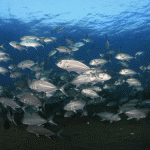
Seagrass meadows also provide vital habitat for marine species. Image: Shutterstock/Rich Carey
Scientists estimate that seagrass meadows can store as much carbon as a forest.
Seagrasses are among the world’s most threatened ecosystems- around 29 per cent of all historic seagrass meadows have been destroyed, mostly due to dredging and water quality degradation. A further 1.5 per cent of these meadows are lost every year.
However, these endangered ecosystems are key sites for carbon storage. Although they occupy less than 0.2 per cent of the world’s oceans, they are responsible for more than 10 per cent of all blue carbon stores, according to University of Western Australia researchers.
“These results show that seagrass meadows are key sites for carbon storage and probably are far more important as carbon dioxide sinks than we realised,” says says Professor Gary Kendrick, lead author of the study published in Nature Geoscience.
The researchers examined 946 seagrass meadows across the globe and found that the coastal beds can store up to 83,000 metric tons of carbon per square kilometre. 90 per cent of this is held in the soils below them and they can build on this indefinitely.
In contrast, a land forest can store approximately 30,000 metric tons per square kilometre. And unlike the trees, which can only store carbon, seagrass can both store and sequester carbon.
The results suggest that seagrass beds are far more important carbon sinks than scientists previously realised.
The scientists also estimated that seagrass meadow destruction can emit up to 25 per cent as much carbon as land deforestation. “Given their spatial extent and given the size of the size of the disturbances, this is a negative in the way we manage seagrasses.”
Professor Kendrick says that if they are restored, they can rapidly re-establish lost carbon sinks, as well as providing a range of other valuable ecosystem benefits. Australia already has legislation in place to protect benthic habitats, which include seagrasses.
“We’re in a situation where… we can both maintain seagrass distributions and store carbon at the same time.”






